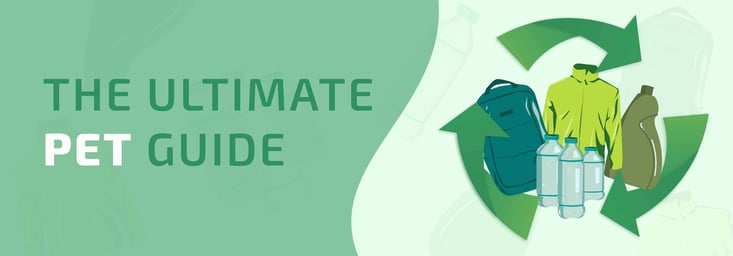Share this
The Ultimate Guide to PET Plastic
by 3devo on Mar 29, 2021 11:36:00 AM
Polyethylene terephthalate, known to most as PET, is the most used thermoplastic polymer. You’ve probably seen the recycle triangle with the number 1 on many beverages and food containers, but that’s only the beginning of PET. If its scientific name or abbreviation doesn’t ring a bell, polyester might. The material is known to make most clothing and other furnishings articles. However, it starts as a clear, strong, and lightweight plastic.
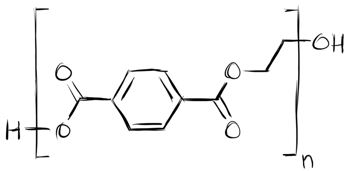
What is PET Plastic?
PET has been around since the 1940s when chemists experimented with polymers to create textiles. The plastic’s popularity grew through the 1950s when researchers found a way to stretch PET into a thin sheet, this form being used mainly for video, photo, and packaging films. When the technology for blow-stretch molding was developed in the early 1970s, PET found a new form and its most notable use, PET bottles. Patented in 1973, PET bottles, compared to its container-predecessors (glass bottles, steel, and aluminum cans), were lightweight, safe, cheap, and recyclable.
Properties of PET
By looking at a polyethylene terephthalate property table, we can understand and gain insight into how it would be working with PET plastic. While there are many variables at play, below, you will find a general material overview. Properties may vary slightly as there are different grades available.
| Density | 1,3 – 1.4 g/cm3 |
|---|---|
| Water Absorprtion – equilibrium (%) | less than 0.7 |
| Upper working temperature | 115 – 170⁰C |
|---|
| Tensile Modulus (GPa) | 2 – 4 |
|---|
| Melting Point | 260⁰C |
|---|
Misconceptions of PET
Despite us interacting with PET daily, any mention of “PET” or “plastic” comes with a sense of taboo. We’ve associated the destruction of our climate with plastic waste. If you’re not picturing a polar bear surrounded by melting ice when “climate change” is mentioned, you’re probably imagining a sea of plastic floating in our oceans.
While PET is the most used plastic, it is also the most recycled. In 2017, 1.923 million tonnes of PET bottles were collected in Europe for recycling, seeing an increase of 2.9% from the previous year. In addition to that, the PET recycling rate was around 58.2%. Besides thinking of PET as one of the culprits behind plastic pollution, a thought that crosses many people’s minds is PET’s harm to our health.
It is essential to acknowledge that many governments worldwide have agencies regulating and providing scientific advice on any risks associated with foods and beverages. PET has been approved by the Food and Drug Association, Health Canada, the European Food Safety Authority, and countless more as safe for contact with food and beverages. While antimony oxide is used during the making of PET, it is only over more extended periods of exposure to heat that trace amounts of antimony may migrate into the beverages bottled in PET. These antimony levels are far below the safety thresholds, and the small amounts that might be found in PET contained foods and beverages are not anything to be concerned about as it does not pose any health risk.
If you still feel hesitant, check out your local food and beverage agency’s requirements on the use of PET containers for edible products.
The Pros and Cons of PET Plastic
Despite the many uses of PET and its popularity, there are certain limitations to it. Below we’ve compared the most common pros and cons when working with PET plastic.
| Pros | Cons |
|---|---|
| The polymers are easily available and inexpensive | Lower heat resistance |
| High strength to weight ratio | PET resins are susceptible to oxidation |
| Highly transparent and shatterproof | Partially derived from crude oils |
| Easily Recycled | Not biodegradable |
PET vs PETG
Although PET is available as a homopolymer (a polymer where every monomer unit of the chain is the same), you can alter it to produce copolymers (a polymer derived from more than one species of monomer) desirable for specific applications. A known copolymer of PET is PETG, which is polyethylene terephthalate glycol-modified. One of the biggest misconceptions, especially in the 3D-printing filament industry, is that PET and PETG are the same. Unfortunately, this is not the case. PETG isn’t made from simply adding glycol to PET. PETG is formed during the initial polymerization process, where monomers/other components are combined to build the polymer up. Below you can see a table of the differences between the two.
| PET | PETG |
|---|---|
| Strength – high impact capability and shatter resistance | Strength – copolymerization keeps it from crystalizing and reduces cracking |
| Better chemical resistance, impact resistance, and clarity | Good chemical and impact resistance and clarity |
| Typical applications – Bottles | Typical applications – Cosmetic packaging |
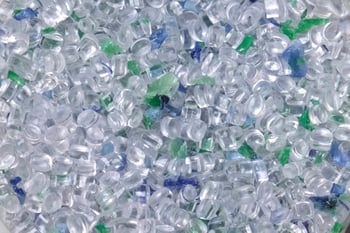
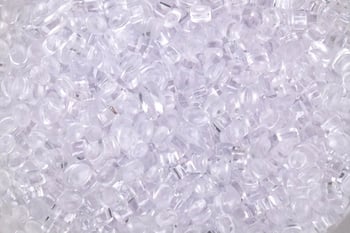
How Is PET Used?
Besides food and beverage containers, PET is a known and familiar material used to create clothing, furnishing, textiles, and more in its polyester form. Famous for its durability and resistance to many chemicals, it retains its shape well and is easy to look after. Besides its use for consumables and wearables, polyethylene terephthalate has been used by the music and marine vessel industries and as fabrics for conveyor belts and fabric coating.
The most common application done with PET is injection molding. Injection molding is the manufacturing process for producing various parts by injecting molten material into a mold and rapidly cooling it off. Once molten PET gets injected into pre-form molds, they can then be blow-molded to create the desired shape after cooling off. We typically see this when making PET bottles, but this same technique is beneficial when producing shampoo bottles, trays, and watering cans.
A lot can be done with PET, given its universality, but what we’ve mentioned is just the beginning.
Industrial Use of PET
Thanks to its excellent electrical insulating properties, PET plastic is widely used in the electrical and electronics industry. PET has replaced die cast metals and thermosets within electrical encapsulation, solar junction boxes, and smart meters, to name a few. Considering its thermal range and its lightweight, PET plastic is mechanically strong; this reason, next to its design freedom and other advantages, has made it a popular material for the automotive industry. Its high abrasion and UV resistance, high stiffness, and low cost make PET very attractive to use throughout an automobile.
Seat belts and seat covers require high abrasion and UV resistance to secure safety and comfort while in a vehicle. With its high abrasion resistance and durability, polyester is used in automobile carpets; alongside being durable against soil, it provides noise insulation. These factors are also why polyester is a commonly used material within the fashion, textile, and home furnishing industries. Polyester fiber is great as insulation material in pillows, comforters, and upholstery padding. The high stain and tear resistance make it an attractive material for clothing, with additional offerings in fewer wrinkles and shrinkage (compared to cotton).

At Fontys University of Applied Sciences, one of the largest and most prominent educational institutes in the Netherlands, the Natural Science wing is one of the only to offer bachelor courses in polymer studies. 3D printing is part of their research facility; it assists students in researching and enhancing existing polymers. Through filament extrusion, students and researchers have been able to study the properties and recyclability of PET.
While Fontys’ students and researchers extruded PET filament, for those who want to go straight into 3D Printing, PET filament is available and accessible. Ultra Fuse FFF provides PET filament, which is as easy to use as PLA but more durable. With different colors to choose from and a sustainable option, you’re sure to find just what you need for your 3D printing projects.
In a time where sustainability is needed in all industries, Freudenberg Performance Materials, a leading global supplier of innovative technical textiles, has found a way to benefit from PET recycling. The supplier from Germany has been able to give PET a second life by making nonwoven materials to seal roofs. Using recycled PET in this innovative way proves that PET shows a lot of promise in its use as virgin and recycled material.
Unleash PET's Potential: Eco-Friendly Filament Maker
Ready to embrace sustainability and unlock the true potential of PET plastic? Our state-of-the-art Filament Maker empowers you to repurpose PET, the most used thermoplastic polymer, into custom 3D printing filament. Say goodbye to plastic waste and hello to endless creative possibilities.

Can PET Be Recycled?
Recycling and reusing go beyond DIY projects at home; from being one of the most recycled plastics, PET has been given new lives within various uses and industries, mainly through becoming rPET.
Unlike PETG, where PET is glycol-modified, rPET means “recycled PET”. Bottles, containers, and other PET items collected and sorted go through shredding and drying, where then rPET is born and can be made into products such as blankets, insulation, car parts, clothing articles, and more!
Although there is a limited global supply of rPET, there is a growing demand. This ever-increasing demand is seen in return bottle schemes; alongside this, the EU stated that by 2030, 90% of all PET products should get collected and reprocessed. Next to that, all newly produced bottles should include 25% rPET. The growing demand for rPET and the change in legislation to have rPET more commonly used are great facts when looking at how much environmentally friendlier rPET is to its predecessor. rPET uses 71% fewer greenhouse emissions, 79% less energy, and has under a quarter of the carbon footprint of the virgin material.
There are, however, two drawbacks that we should mention when comparing the two plastics. rPET can have a slightly different hue to PET due to impurities; however, using a mix of the two can quickly correct this. The other one being that rPET is more expensive than PET as high-quality granulate is in a lower supply.
Aside from the economic and environmental factors, the recycled and virgin material are the same: they are both shatterproof, lightweight, and approved by various food and beverage agencies as being suitable for food, health, and home care products.
3D Printing and Recycled PET
If you’re looking for other ways to take control over your plastic waste, 3D printing filament could be an option. Through 3D printing, you have full control to create whatever you’d like.
The Extreme E racing series is the first sport conceived with concern for the climate crisis. By using electric racing in remote environments facing the threat of climate change, the series’ goal is to highlight and encourage all of us to take action to protect our planet’s future and wellbeing. That is why, while en route to their racing locations onboard St. Helena, the team will collect ocean PET, process it, and make it into filament, which will, in turn, be used to 3D print the winning teams’ trophies. Not only does this show how there are endless possibilities when working with rPET, but it is also a great example of closed-loop recycling.
It might sound as easy as home projects when you want to move into the 3D printing possibilities of rPET, but you have to be aware that trial and error will occur; this is something we learned the first time we experimented with creating filament from rPET. It ended with several trial runs that resulted from adjustments made throughout, but it is doable! Since then, we’ve learned a lot about what it takes to create 3D printable filament from recycled PET, and have been successfully able to do so.
Be warned, patience is required.
How Can PET Be Applied in 3D Printing?
Earlier, we listed some of PET’s properties, but some properties and variables will be more of an interest to you when you want to extrude and create PET filament. Aside from the physical and mechanical properties listed earlier, thermal and processing properties are fundamental here.
An important reminder, however, is that the processing properties may differ depending on your PET manufacturer. That’s why we suggest following the guidelines given to you by them and being aware that depending on the hardware you’re using to extrude the filament, you may have to adjust the different variables as the settings you use on one extruder might not work on another. Processing properties are more “applied” and “hands-on” than other properties, and you’ll have to work and change as you go.
| Upper working temperature | 115 – 170⁰C |
| Lower working temperature | -40 – -60⁰C |
| Melting point | 260⁰C |
| Drying Temperature | 120⁰C |
| Extrusion Temperature | 270-290⁰C |
5 Steps To 3D Printing With PET
Now that we know which properties we should pay attention to, we can get into the steps you’ll need to take to repurpose PET into a 3D print successfully.
1. Prepping Your PET
Before getting your PET products to a size that can go through an extruder, you need to morph it into a shape that can go through a shredder. There are three approaches you can take with this Crushing it with your hands, so it’s narrow enough to feed through a shredder. Use a vacuum to vacuum out the air and deflate the plastic. Cutting your material with scissors into smaller and more manageable pieces.
2. Shredding
The best solution is to use a shredder to get your PET plastic into more refined pieces (smaller than 4mm). This process is faster than if you were to continue cutting with scissors. To extrude the regrinds, they have to be small enough for your filament extruder to melt it and push it through; if it’s too big, not only may it not fit, but it may cause a blockage.
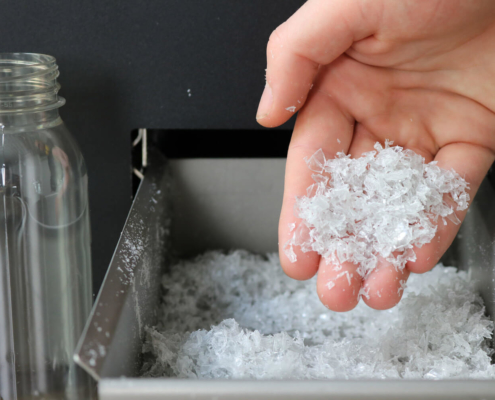
3. Drying
PET is hygroscopic, meaning that it absorbs moisture from the air. When extruding a material, moisture can affect the quality and texture of the filament. To dry your regrinds, you can either choose to use an industrial dryer or dry it in your oven at home! Once it’s dried and as much moisture as possible is drawn from the regrinds, you can start extruding.
4. Extruding
Before extruding, you need to remember that there are different PET grades, and each filament extruder will require various changes depending on this. Experimentation is key here. We suggest testing out different temperatures in steps of 5°C while waiting in between to look at the tolerance. Once you feel confident in the set temperatures, it’s time to change the extrusion speed in increments of 0.5RPM and the fan cooling temperature.
Once you’ve extruded your filament, if you don’t plan on using it to 3D print immediately, then store it in a dry place or vacuum seal it to prevent it from drawing in moisture from the air.
5. 3D Printing
Your rPET filament is now ready for you to print! Experimentation is the name of the game here, from extruding and continuing with the 3D printing. Before going full speed ahead and printing the actual print you want to create, we suggest trying a smaller print. This way, you can see how your rPET filament will react.
Some variables you should keep in mind are the temperature and printing settings. If you have too high of a temperature setting, your filament might melt too quickly, and your 3D print won’t be even. Here are general guidelines to which settings you should put your 3D printer to, but, as mentioned earlier, every hardware is different, and you might have to react to what output you’re receiving.
| Nozzle size: ≥0.15mm | Layer height: ≥0.1mm | Flow rate: ±110% |
| Print temp: ±200 – 240⁰C | Print speed: High | Retraction: Yes ±6mm |
| Heat bed: ±65 – 75⁰C | Fan speed: 0-30% | Experience level: Beginner |
Once you’ve tested out your printer with your rPET, you can create your final design! While there is a limit on the settings, there is no limit to how creative you can get with your 3D prints!
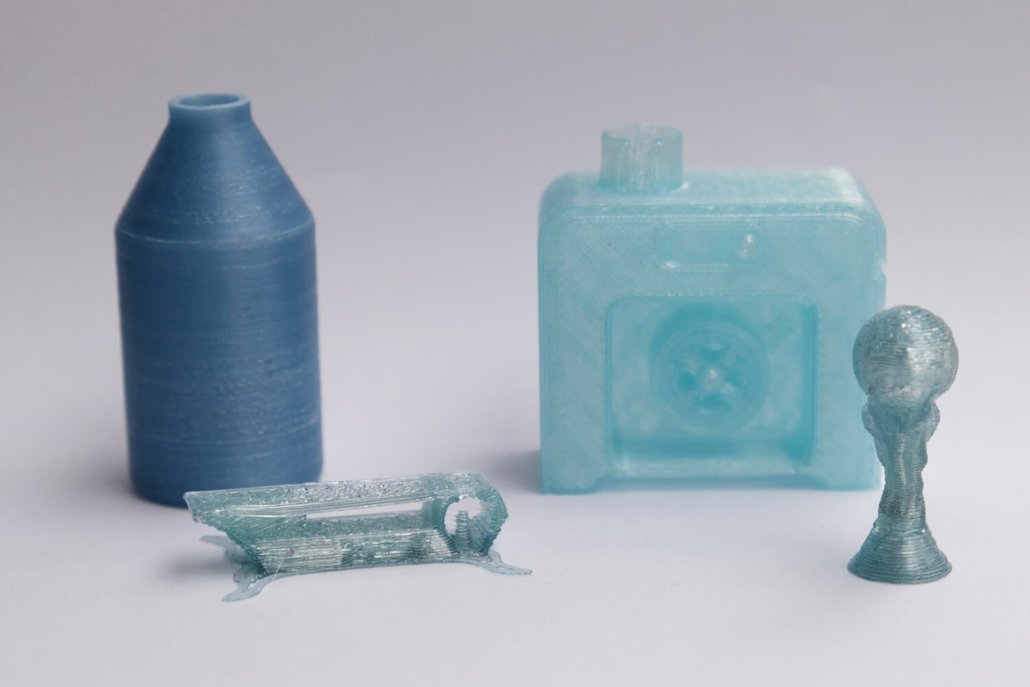
If you’re not into 3D printing, or have access to the equipment necessary to reuse PET in this way, luckily there are countless projects that you can get started on to give it a new life.
How Can I Repurpose PET?
It can be easy to recycle PET at home, give it a new life, and enjoy the time as a creative outlet. PET can be recycled in multiple ways at home with various degrees of difficulty. Here are three projects which will help you recycle with it at home:
- PET typically starts as food containers and can easily continue that path; reuse your coffee creamer bottles to store sugar, spice, and everything nice for minimal storage and an easier pour.
- Keeping a plant alive can be tricky, but this craft will be just the incentive you needed to continue trying! Plant pots can be expensive in the long run and not as colorful as some of us may like. Turn your empty bottles into hanging planters and customize them by painting the outside with your favorite color!
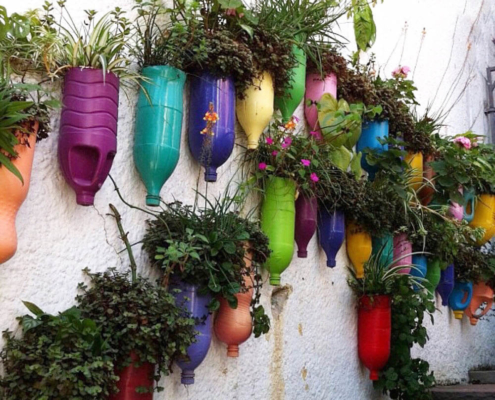
- Fight plastic waste with plastic waste! Turn your larger PET bottles into a plastic bag dispenser. Make it easier for yourself to collect something that is typically seen as a one-time use option, and use the plastic bags for varied uses! Start by gathering the bags you get from your grocery runs and use them as trash can linings, storage bags, and the bags you continue to use for your grocery runs! If the bags show signs of wear and tear, you can decide to create gift bows for the final piece of a gift or make custom coin pouches. Like PET bottles, plastic bags have huge repurpose potential!
Hopefully, if you didn’t know before, you know now why PET is still one of the most used plastics. Its universality is shown as different products within one industry and through its versatility in various sectors. Not only can it be recycled and reused into a product with the same level of quality as the virgin product, but it is the most recycled plastic out there! These qualities enable it to contribute to a circular economy in ways such as return schemes.
Its varying application forms and reusability make it an attractive material to extrude filament and 3D print with, all the while gaining valuable knowledge on its properties.
Recycle and Create! Get the Polymer Shredder Now!
Turn PET plastic into 3D printing gold! Get our Polymer Shredder to unlock limitless possibilities and innovate today!
.png?width=1103&height=996&name=My%20project%20(1).png)
Share this
- April 2024 (2)
- March 2024 (1)
- January 2024 (1)
- November 2023 (2)
- October 2023 (5)
- September 2023 (2)
- August 2023 (1)
- May 2023 (1)
- January 2023 (1)
- December 2022 (3)
- August 2022 (1)
- June 2022 (1)
- May 2022 (2)
- April 2022 (2)
- March 2022 (7)
- February 2022 (2)
- January 2022 (3)
- December 2021 (3)
- November 2021 (3)
- October 2021 (3)
- September 2021 (3)
- August 2021 (3)
- July 2021 (2)
- June 2021 (1)
- March 2021 (1)
- October 2020 (1)
- June 2020 (1)
- May 2020 (1)
- April 2020 (4)
- November 2019 (1)
- July 2019 (2)
- June 2019 (1)
- May 2019 (1)
- March 2019 (1)
- November 2018 (1)
- September 2018 (1)
- January 2018 (1)
- October 2017 (1)
- September 2017 (1)
- July 2017 (1)
- June 2017 (1)
- May 2017 (1)
- January 2017 (1)
- December 2016 (3)
- November 2016 (2)
- October 2016 (1)
- May 2016 (2)
- August 2015 (3)
- July 2015 (1)
